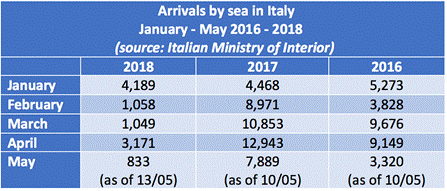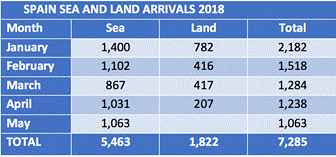-
Who we are
WHO WE AREThe International Organization for Migration (IOM) is part of the United Nations System as the leading inter-governmental organization promoting since 1951 humane and orderly migration for the benefit of all, with 175 member states and a presence in 171 countries.
-
Our Work
Our WorkAs the leading inter-governmental organization promoting since 1951 humane and orderly migration, IOM plays a key role to support the achievement of the 2030 Agenda through different areas of intervention that connect both humanitarian assistance and sustainable development.
What We Do
What We Do
Partnerships
Partnerships
Highlights
Highlights
- Where we work
-
Take Action
Take Action
Work with us
Work with us
Get involved
Get involved
- Data and Research
- 2030 Agenda
Mediterranean Migrant Arrivals Reach 25,338 in 2018; Deaths Reach 628
Geneva – IOM, the UN Migration Agency, reports that 25,338 migrants and refugees entered Europe by sea through the first 19 weeks of 2018, with about 41 per cent arriving in Italy and 38 per cent to Greece, with the remainder (21%) arriving in Spain.
This compares with 54,324 arrivals across the region through the same period last year and about 188,000 at this time in 2016.
In other words: Mediterranean arrivals at this point in 2018 are running at under half last year’s level on this date, and about 13 per cent of 2016’s arrivals at this point in the year.

IOM Rome’s Flavio Di Giacomo noted that the 10,300 migrants who are registered as having arrived by sea to Italy this year is an amount 77 per cent less than that reported last year in the same period, when 45,124 irregular migrants and refugees arrived in Italy and a 67 per cent decline from the 31,246 arriving to this point in 2016 (see chart below).

Di Giacomo added that almost 500 migrants were rescued at sea last Saturday (12 May) during six operations carried out by Italian and international ships. Some migrants arrived from Libya, others from Tunisia.
He noted that in one case, rescuers provided support to a two-deck wooden boat carrying 180 people. The boat had left from Kekhenna (Tunisia) on Friday night, and was rescued by a ship of the Italian Coast Guard and one of Carabinieri a few miles off Lampedusa. Migrants reported to IOM staff to have paid EUR 1,200 for the sea crossing, and that they had been ferried out by smugglers to the larger “mother ship” waiting for them in open water.
According to these witnesses, some migrants saw that the boat was overloaded and subsequently changed their minds about embarking – but the smugglers then used violence to force them on board.
“We haven’t seen the arrival of such a big boat from Tunisia for some time,” said Federico Soda, Director of the IOM Coordination Office for the Mediterranean. “The use of larger boats that are loaded with hundreds of people was more common in past years, up to about mid-2015. More recently, mostly rubber dinghies, departing from Libya or small wooden boats departing from Tunisia, have been used by smugglers to move migrants into international waters. It is difficult to know whether the type of boat used for this group represents a return to past practices.”
During another operation, the SOS Mediterranée’s Aquarius rescued 74 migrants, who were travelling on a rubber dinghy and who shared with the rescuers the horrific stories and the extreme danger and violence they experienced in Libya.
IOM Rome also noted Tunisians represent the largest nationality group arriving in Italy by sea from North Africa this year, followed by Eritreans, Nigerians, Sudanese, Pakistan, Malians, Guineans and Senegalese—almost all of whose arrival numbers have fallen considerably below totals reported in the recent months. (see chart below).

IOM Libya’s Christine Petré reported that on Sunday, 257 migrants (including 18 children) were returned to Libyan shore by the Coast Guard in two different search and rescue operations. IOM provided migrants with emergency humanitarian assistance including basic health and protection screenings, as well as food and beverages. Migrants were transferred to Tajoura and Shuhada al Nasr detention centres, where IOM assistance continues.
So far this year, 6,642 migrants have been returned to Libyan shore by the Libyan Coast Guard, Petré reported.
IOM’s Missing Migrants Project reported on Monday (14 May) that in the Mediterranean alone, 628 migrants are estimated to have died this year. The latest fatalities this year are being reported as nine individuals discovered near the Karpasia peninsula in Northern Cyprus on Sunday. Authorities believe those casualty numbers may increase and so far some remains have been confirmed as Syrians.
The Turkish Coast Guard on Monday was undertaking a search operation. It is believed that the migrants’ departure was from Mersin, Turkey, and that their boat likely sank last week.
To date this year the 383 drownings on the Central Mediterranean route linking North Africa to Italy has been the region’s deadliest sea crossing. Twenty-eight drowning victims have been discovered this year in the Turkish-Greek waters of the Eastern Mediterranean and 217 in the waters separating North Africa from Spain.
In Spanish waters, so far this year, IOM Madrid’s Ana Dodevska reported Monday that a total of 1,063 migrants have been rescued on the Western Mediterranean route through 13 days in May – compared with 835 for the entire month of May last year. That brings to 5,463 the total number of men, women and children who have been rescued trying to enter Spain by sea this year (see charts below).



IOM Greece’s Kelly Namia reported Monday that over the four days (9-12 May) the Hellenic Coast Guard reported at least two incidents requiring search and rescue operations off the island of Lesvos and Kos. The Coast Guard rescued 24 migrants and transferred them to those two islands.
Namia reported that along with other landings on Lesvos and Leros another 67 migrants landed in the Aegean these four days bringing to 9,528 the total number of irregular migrants entering Greece via sea since 1 January—for an average of around 72 persons per day.
April saw 3,083 migrant arrivals via the Eastern Mediterranean. Already 1,263 irregular migrants have landed on these shores in May—just 12 days into the month. (see charts below)


Ivona Zakoska, an IOM regional officer for Southeastern Europe and Central Asia, reported on Monday that available data show that irregular arrivals through the Eastern Mediterranean route doubled this year, when compared with arrivals during the same period in 2017.
Between January and April, Greek authorities registered more than 10,400 new arrivals compared to 5,771 reported in 2017. New arrivals – and the prolonged presence of a significant number of stranded migrants in the transit countries (estimated at more than 62,000 at the end of April 2018) – result in increased further movement of migrants through the Western Balkan countries: Albania, Montenegro and Bosnia and Herzegovina.
Authorities in those respective countries registered the arrival of 4,648 irregular migrants since the start of the year through the end of April, a figure that represents an almost ten-fold increase compared to the same period last year. A majority of these irregular migrants has been detected in the territory of Bosnia and Herzegovina—over 2700 individuals. Almost one quarter of the migrants and asylum seekers registered in Bosnia and Herzegovina were Syrian nationals (641) followed by nationals of Pakistan, Libya, Afghanistan and Iran. The nationality breakdown of the migrants and asylum seekers registered in Albania and Montenegro are similar, with a slightly higher share of migrants from Algeria who were also registered among the top five nationality groups.
Worldwide, IOM’s Missing Migrants Project has recorded 1,106 people who died or went missing while migrating in 2018 (see chart below).
On the US-Mexico border, a young man of unconfirmed nationality drowned in a canal in Brackettville, Texas, after crossing the US-Mexico border on 11 May. Additionally, the US Border Patrol reported that the remains of an unidentified migrant were found near Armstrong, Texas, on 10 May. On 7 May, another body was recovered from a ranch near Falfurrias, Brooks County. Located over 70 miles from the border with Mexico, Falfurrias hosts one of the border region's busiest immigration checkpoints; Brooks County is regularly crossed by migrants trying to avoid detection. This year, at least 20 bodies have been found in ranch lands across Brooks County, according to the Brooks County Sheriff’s Office. That's a rate of more than one victim per week.
Additionally, the MMP team recorded the deaths of 13 migrants from Comoros who lost their lives when crossing the Mozambique Channel to reach the French island of Mayotte on 5 May. One survivor was rescued by local fishermen, who also recovered the body of a young woman. According to the testimony of the sole survivor, a 70-year-old woman, at least 12 people are missing and presumed dead in this tragic accident.

Missing Migrants Project data are compiled by IOM staff but come from a variety of sources, some of which are unofficial. To learn more about how data on migrants’ deaths and disappearances are collected, click here.
Latest Mediterranean Update infographic here
For latest arrivals and fatalities in the Mediterranean, please visit: http://migration.iom.int/europe
Learn more about the Missing Migrants Project at: http://missingmigrants.iom.int
For more information, please contact:
Joel Millman at IOM HQ, Tel: +41 79 103 8720, Email: jmillman@iom.int
Flavio Di Giacomo, IOM Coordination Office for the Mediterranean, Italy, Tel: +39 347 089 8996, Email: fdigiacomo@iom.int
Hicham Hasnaoui, IOM Morocco, Tel: + 212 5 37 65 28 81, Email: hhasnaoui@iom.int
Kelly Namia, IOM Greece, Tel: +30 210 991 2174, Email: knamia@iom.int
Ivona Zakoska, IOM Regional Office for South-Eastern Europe, Eastern Europe and Central Asia, Austria, Tel: +43 1 5812222, Email: izakoska@iom.int
Julia Black, IOM GMDAC, Germany, Tel: +49 30 278 778 27, Email: jblack@iom.int
Christine Petré, IOM Libya. Tel. +216 29 240 448, Email : chpetre@iom.int
Ana Dodevska, IOM Spain, Tel: +34 91 445 7116, Email: adodevska@iom.int
Myriam Chabbi, IOM Tunisia, Mobile: +216 28 78 78 05, Tel: +216 71 860 312 Ext 109, Email: mchabbi@iom.int